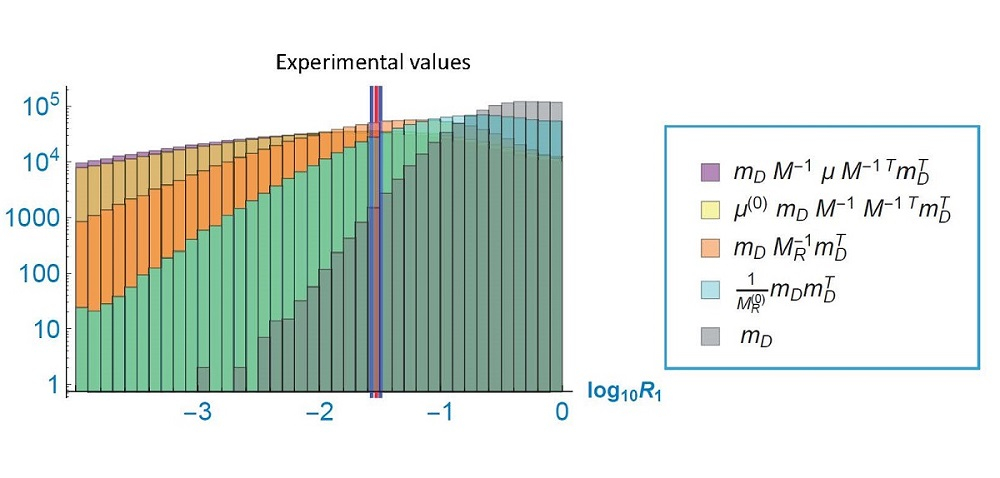Research News
Apr 6, 2023
Random matrix theory approaches the mystery of the neutrino mass!

Probability distributions of different neutrino mass models.
The horizontal axis shows the ordinary logarithm of the neutrino mass squared difference ratio, while the vertical axis shows their probability distribution. Each histograms represent the probability distributions for the seesaw mechanisms of the corresponding color. The vertical red and blue lines represent the experimental values (1σ and 3σ errors) of the ordinary logarithm of the neutrino mass squared difference ratio. The probability distribution for the seesaw model with the random Dirac and Majorana matrices in orange has the highest probability of reproducing the experimental value.
When any matter is divided into smaller and smaller pieces, eventually all you are left with—when it cannot be divided any further—is a particle. Currently, there are 12 different known elementary particles, which in turn are made up of quarks and leptons each of which come in six different flavors. These flavors are grouped into three generations—each with one charged and one neutral lepton—to form different particles, including the electron, muon, and tau neutrinos. In the Standard Model, the masses of the three generations of neutrinos are represented by a three-by-three matrix.
A research team led by Professor Naoyuki Haba from the Osaka Metropolitan University Graduate School of Science, analyzed the collection of leptons that make up the neutrino mass matrix. Neutrinos are known to have less difference in mass between generations than other elementary particles, so the research team considered that neutrinos are roughly equal in mass between generations. They analyzed the neutrino mass matrix by randomly assigning each element of the matrix. They showed theoretically, using the random mass matrix model that the lepton flavor mixings are large.
“Clarifying the properties of elementary particles leads to the exploration of the universe and ultimately to the grand theme of where we came from!” Professor Haba explained. “Beyond the remaining mysteries of the Standard Model, there is a whole new world of physics.”
After studying the neutrino mass anarchy in the Dirac neutrino, seesaw, double seesaw models, the researchers found that the anarchy approach requires that the measure of the matrix should obey the Gaussian distribution. Having considered several models of light neutrino mass where the matrix is composed of the product of several random matrices, the research team was able to prove, as best they could at this stage, why the calculation of the squared difference of the neutrino masses are closest with the experimental results in the case of the seesaw model with the random Dirac and Majorana matrices.
“In this study, we showed that the neutrino mass hierarchy can be mathematically explained using random matrix theory. However, this proof is not mathematically complete and is expected to be rigorously proven as random matrix theory continues to develop,” said Professor Haba. “In the future, we will continue with our challenge of elucidating the three-generation copy structure of elementary particles, the essential nature of which is still completely unknown both theoretically and experimentally.”
Their findings were published in Progress of Theoretical and Experimental Physics.
Funding
This work is partially supported by Scientific Grants from the Ministry of Education, Culture, Sports, Science and Technology of Japan, Nos. 17K05415, 18H04590, and 19H051061 (NH), and No. 19K147101 (TY).
Paper Information
Journal: Progress of Theoretical and Experimental Physics
Title: Neutrino mass square ratio and neutrinoless double beta decay in random neutrino mass matrices
DOI: 10.1093/ptep/ptad010
Author: Naoyuki Haba, Yasuhiro Shimizu, Toshifumi Yamada
Publish: March 1, 2023
https://academic.oup.com/ptep/article/2023/2/023B07/6992884
Contact
Graduate School of Science
Naoyuki HABA
E-mail: haba [at] omu.ac.jp
*Please change [at] to @.
SDGs
